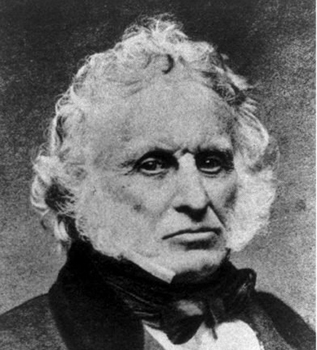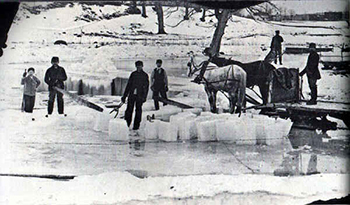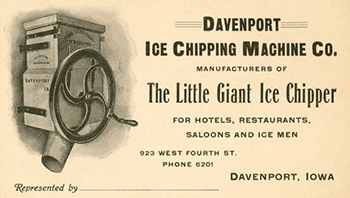Ice is more integral to modern cocktails than any other single ingredient.
With very few exceptions ice touches every drink that passes into the hands of our expectant guests. Yet ice is a reasonably recent addition to the history of the mixed alcoholic drink.

It was right at the start of the 1800’s that, thanks to a couple of entrepreneurial brothers in the US, ice began to be more than something that happened in the winter. Of course for centuries ice had been used to preserve food in various ways and in actual fact the likes of the Romans and Henry III had used ice to show off at big parties to chill wine. However Frederic & William Tudor were the ones to see the opportunity to produce and sell it.
The brothers had two advantages on their side, one being their family was minted, and secondly they were based in Boston which has a lot of ice for a lot of the year. Although it is Frederic who became known as the ‘Ice King’ it was actually William’s original idea.
He looked at a frozen lake on the family estate and pointed out that they should take the ice and sell it to people living in the West Indies. It may have been a throwaway joke to William but Frederic (who was a bit of a family failure up until this point) decided the idea was genius.
Getting the ice to the islands wasn’t all plain sailing, in actual fact it was considered such a bad idea by everyone they spoke to that no ship would take their cargo for them. Despite his conviction that packing the ice in sawdust would stop it melting others didn’t agree and were worried the ice would melt and the resulting water would ruin the other cargo or even the integrity of their vessels. Luckily when you have plenty of cash this sort of thing isn’t so much of a problem and the brothers simply bought their own ship in 1806.
Unfortunately when they arrived in Martinique no-one, despite the tropical heat, wanted the ice. William decided the joke had gone on too long and left his brother to it. Another failed trip followed the next year and then a trade embargo ended his plans for working in the West Indies.
It wasn’t looking good for Frederic, his family lost a chunk of its fortune in a dodgy deal and no-one seemed to get behind his idea. He spent time either in prison or hiding from the law, all the time whilst trying to make a success of his business.
It seems he was a stubborn git though and didn’t give up on his dream of getting rich from frozen water. He would visit bars and convince bartenders to served chilled drinks alongside normal ones to see which their customers would prefer, and showed restaurants how to make proper ice cream. Finally by 1821 he had managed to convince people that ice was where it was at and had built up strongholds in the likes of New Orleans, Savannah and Charleston. He’d even managed to get across to Havana and build business there.
By 1838 ice was such a staple of the US culture that the New York Mirror wrote how an ice box (used at home to store ice delivered by the ice harvesters) ‘‘is now considered as much an article of necessity as a carpet or dining-table”.
The problem Frederic had however was that the production of ice was both dangerous (injuries and even death were commonplace for the workers ‘farming’ the ice from lakes) and yield (only about 10% of harvested ice ever made it to sale). He was joined by Nathaniel Wyeth who streamlined the harvesting techniques and enabled Tudor’s ice business to become the largest in America and export around the world.
By the time of his death in 1864 he was once again a rich man, however he had created a monster and the nation’s love of all things chilled had led to numerous companies getting in on the ice action. By the turn of the century it was one of the biggest industries in the country. However, as is so often the way, its own success led to its own downfall.
Icy Reception
The first ice-making machine was actually invented way back in 1845 by Dr John Gorrie in Mississippi. He launched it at a Bastille Day party in Florida when wine was served on a bed of his machine made ice in the heat of the summer (just like old Henry III). It was a sensation. However it never took off (partly because his machine was expensive and a bit shit) and he died in 1855 in poverty.

It was a Frenchman, Ferdinand Carre, who made the first ice machine to become a commercial success, named rather snappily the Ammonia Vapor Absorption Cycle Ice Manufacturing Machine. Once it made it to the US a Kentucky gentleman by the name of Daniel Livingston Holden figured out if you put distilled water through a Carre machine it came out crystal clear, much more like the harvested ice people were used to.
Slowly ice machines started to appear across the US but they were commercial units and not built for homes. Much like the harvested ice, the Carre ice would be delivered to people’s homes and put in an ice box.
In the bar industry ice had taken on a new role. In the years leading up to prohibition the new influx had allowed ice to be used as more than just a way to chill a drink before serving. Ice was now becoming an integral part of the serve, be it beautiful clear cubes or lashings of shaved, a mark of a good bar was the quality of its ice (sound familiar?). During prohibition no one gave a crap about ice in their drinks, they just wanted the liquid, but shortly after repeal day ice once again became an instrumental part of our industry.
Unfortunately technology came along and buggered it. At the end of prohibition only 1% of Americans had a refrigerator in their homes by the 1950’s that number had risen to over 80%. By the 1960’s ice was being made at home and these machines found their way into bars, gone was the beautiful ice from the lakes, the large blocks and cubes from the Carre machines. It was replaced by the shitty hotel ice that is still prevalent in a lot of pubs across the UK.
All Right Stop, Collaborate & Listen
Ice is back with my brand new invention (you didn’t think we’d go this whole article without a Vanilla Ice lyric did you?). You may be wondering why BarLifeUK has been focusing so much on the US when it comes to the history of ice. Well simply put, they were better at it than us.

Unlike our transatlantic cousins we don’t have vast expanses of fresh water lakes that regularly freeze to the point they can be harvested. It wasn’t until the late 19th century that we were able to get in on the ice action when steamships allowed vast blocks of ice to be shipped over from the US and Canada. However even then the ice was exceptionally expensive and basically a fad for the country’s elite, never something that caught on with the general public or anything but the very best of bars.
We have, up until the very recent past, lagged behind our American friends when it comes to ice. Even now they can often be heard mocking us as someone drags 5 half melted cubes of ice out of a water filled bucket in a pub to create a gin and tonic (often from a very expensive G&T list). However in recent years that has all changed.
The UK bar scene has been at the forefront of the resurgence of ice in the cocktail industry. Whilst US bars were busy coming up ‘Ice Programmes’ (tossers) we were busy looking not only at technology (admittedly mainly American – yes Hoshizaki is a US company) but also techniques from Asia, who by the way were harvesting ice from lakes long before the Americans.
As with all things in life, and especially in our industry, ice probably got a bit out of hand a few years ago but now it is being used exactly how it should be. Firstly to chill down your drink to perfection and secondly to add a bit of theatre to the serve. However let’s not forget Frederic and, more importantly, all of the workers on the ice farms for their sacrifices all those years ago.
Yo man let’s get out of here. Word to your mother.


